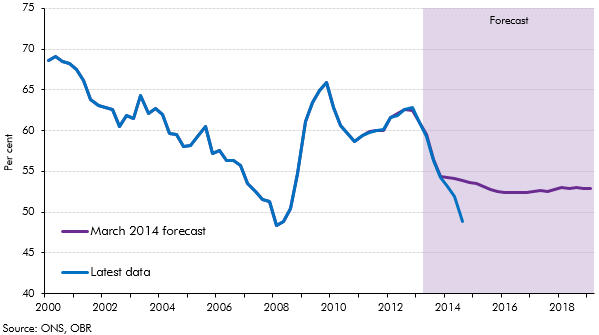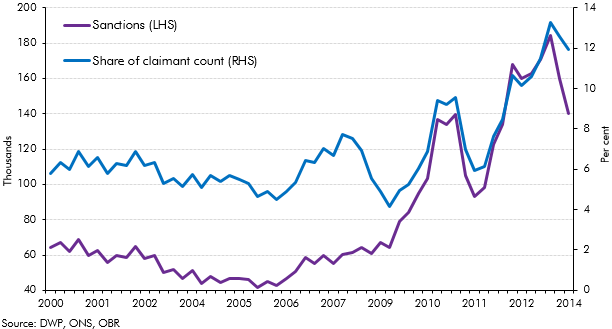In our 2014 Welfare trends report, Chapter 8 considered spending on unemployed people. This box compared outturn data on unemployment and claimants of unemployment benefits to the levels implied by our March 2014 forecast. As the economy performed better than anticipated in our March 2014 forecast, the ratio of claimants of unemployed benefits to the Labour Force Survey (LFS) measure of unemployment deviated from our projections. This was largely due to a drop in the rate of inflows into unemployment benefits and a rise in the rate of outflows from unemployment benefits, though an increase in the number of people looking for jobs but not claiming unemployment benefits may have increased LFS unemployment and so been a contributing factor.
This box is based on ONS unemployment and DWP JSA allowance data from September 2014 and May 2014 respectively.
The labour market has continued to perform better than we expected this year. Growth in real GDP has mainly reflected rising employment, with little contribution from productivity growth. The Labour Force Survey (LFS) measure of unemployment has therefore fallen faster than our March 2014 forecast suggested. The fall in JSA claimants has exceeded our forecast by even more, pushing the ratio of the claimant count to LFS unemployment well below the level implied by our March forecast (Chart A).
Chart A: Ratio of claimant count to LFS unemployment

Between its recent peak in November 2012 and July 2014, the number of LFS unemployed fell by 474,000 while the claimant count fell by 573,000. This is despite the level of LFS unemployment having been 916,000 higher in November 2012. The claimant count fell by 36 per cent over the period compared to 19 per cent for LFS unemployment.
The main driver of the sharp fall in the claimant count has been a drop in the rate of inflows. In November 2012, 0.6 per cent of the working-age population moved into the claimant count. The rate had fallen by a third to only 0.4 per cent in August 2014. A rise in the rate of outflows also played a role. In August 2014, 24.5 per cent of claimants moved off the claimant count compared to 19.6 per cent in November 2012. The increase in the outflow rate from LFS unemployed to employment has been smaller than that in the outflow rate from the claimant count to employment. This suggests that a disproportionate share of people moving into employment from unemployment were previously on the claimant count.
The reduction in the rate of inflows could partly be the result of a new JSA sanctions regime, the set of penalties applied when people break the rules they have to keep to receive their benefit. In October 2012 – just before the claimant count ratio started falling – the Department for Work and Pensions introduced a stricter three-step sanction system. A first failure to comply with the JSA rules results in sanctions broadly in line with the previous system. But second and subsequent failures result in harsher sanctions.a Neither the level nor the rate of sanctions has increased dramatically since October 2012 (Chart B), but the existence and perception of the new regime may have deterred some unemployed people from applying for JSA. That would push down the claimant count ratio.
Chart B: Total jobseeker’s allowance sanctions

Another potential reason for the fall in the claimant count ratio is labour market inactivity, which has fallen faster than expected. Between November 2012 and July 2014, labour market activity increased by 435,000, with some previously discouraged workers likely to have started looking for work as labour market conditions improved. If any of these people who are newly active in the labour market did not move into employment, but also did not move onto JSA, it would hold LFS unemployment up relative to the claimant count.
The recent unexpected fall in the claimant count ratio has also partly coincided with a rise in the number of people claiming incapacity benefits. Since August 2013, the number of claimants has risen by 70,000. But even if there were a direct link with the falling claimant count, this would only explain a small part of the 390,000 fall over the same period.
